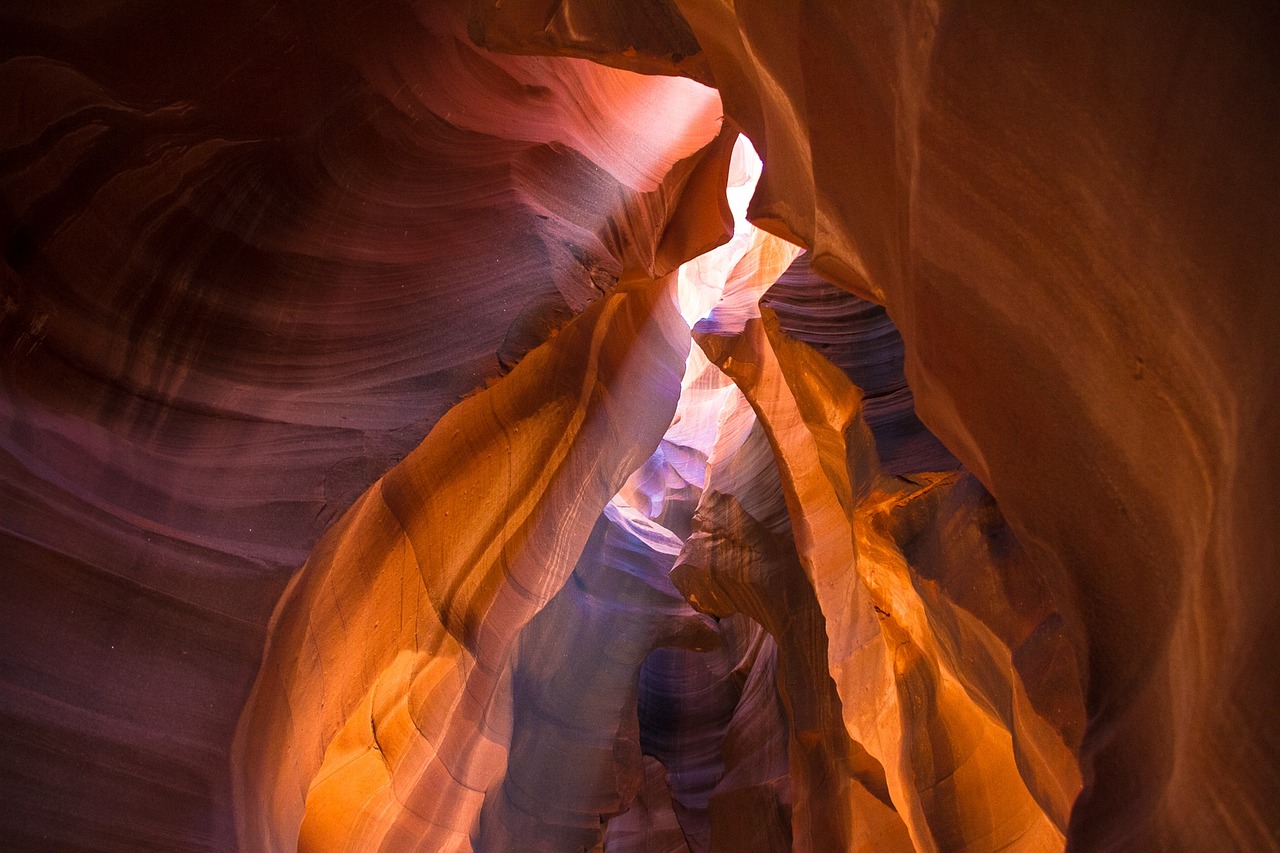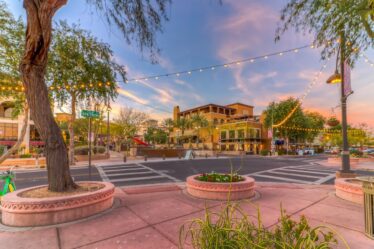
Antelope Canyon, located in the American Southwest near Page, Arizona, is one of the most stunning and popular slot canyons in the world. Known for its narrow passageways, sculpted sandstone walls, and the mesmerizing play of light and shadows, Antelope Canyon is a paradise for photographers and nature lovers alike. This comprehensive guide delves into the geological formation, visitor information, tours, and photography tips to help you make the most of your visit to this natural wonder.
Geological Formation
Origins of Antelope Canyon
Antelope Canyon is composed of Navajo Sandstone, formed over 190 million years ago during the Jurassic period. The canyon itself was carved out by flash flooding, which occurs when rainwater rushes through the narrow passageways, eroding and smoothing the sandstone walls over thousands of years. This process created the canyon’s signature flowing shapes and wave-like patterns.
Structure of the Canyon
Antelope Canyon is divided into two main sections: Upper Antelope Canyon (known as “The Crack”) and Lower Antelope Canyon (known as “The Corkscrew”). Each section offers a unique experience and stunning visual spectacle.
- Upper Antelope Canyon: The more popular of the two, Upper Antelope Canyon is characterized by its easy access and wider passageways. The famous light beams that pierce through the narrow openings at the top of the canyon are a major draw for photographers.
- Lower Antelope Canyon: Known for its narrow, twisting corridors, Lower Antelope Canyon requires more physical agility to navigate. While it lacks the prominent light beams of the Upper Canyon, it offers equally spectacular views and fewer crowds.
Visitor Information
Getting There
Antelope Canyon is located near the town of Page in northern Arizona, close to the Utah border. Page is accessible by car from several major cities:
- From Flagstaff, Arizona: Approximately a 2-hour drive (130 miles).
- From Las Vegas, Nevada: Approximately a 4.5-hour drive (280 miles).
- From Phoenix, Arizona: Approximately a 4.5-hour drive (275 miles).
Weather and Best Time to Visit
Antelope Canyon can be visited year-round, but the best time to experience the iconic light beams in Upper Antelope Canyon is between March and October, when the sun is high in the sky.
- Spring and Fall: Mild temperatures and fewer crowds make these seasons ideal for visiting.
- Summer: Light beams are most visible, but temperatures can be extremely hot, and crowds are at their peak.
- Winter: Cooler temperatures and fewer visitors, but light beams are less frequent.
Tours and Permits
Guided Tours
Both sections of Antelope Canyon can only be visited with a guided tour operated by authorized Navajo tour companies. These tours ensure the safety of visitors and help preserve the delicate environment of the canyon.
- Upper Antelope Canyon Tours: Typically last 1-1.5 hours and focus on the light beams and the canyon’s most famous features.
- Lower Antelope Canyon Tours: Usually last 1.5-2 hours and involve more climbing and navigating through narrow passageways.
Booking Tips
- Advance Reservations: Tours often sell out months in advance, especially during peak season, so booking early is recommended.
- Photography Tours: Special photography tours are available for serious photographers, providing more time and less crowding to capture the perfect shot.
- Weather Considerations: Tours can be canceled due to flash flooding or adverse weather conditions. Always check the weather forecast and tour operator policies.
Photography Tips
Capturing the Beauty of Antelope Canyon
Antelope Canyon is one of the most photographed natural wonders in the world. Here are some tips to help you capture its stunning beauty:
- Camera Settings: Use a tripod for stability in low-light conditions. A wide-angle lens (16-35mm) is ideal for capturing the sweeping curves and narrow passageways. Set a low ISO (100-400) to minimize noise, and use a small aperture (f/8-f/16) for a greater depth of field.
- Light Beams: The light beams in Upper Antelope Canyon are best photographed between 10 a.m. and 1 p.m. during the summer months. Use a slow shutter speed to capture the beams, and consider using a polarizing filter to reduce glare.
- Exposure: The contrasting light and shadow can make exposure challenging. Bracketing your shots and using HDR techniques can help balance the exposure.
- Respect the Environment: Always follow your guide’s instructions and avoid touching the canyon walls to preserve the natural formations.
Nearby Attractions
Horseshoe Bend
Located just a short drive from Antelope Canyon, Horseshoe Bend is a spectacular viewpoint overlooking a dramatic meander of the Colorado River. The short hike to the viewpoint offers stunning panoramic views and is a must-visit when in the area.
Lake Powell and Glen Canyon National Recreation Area
Lake Powell, a massive reservoir on the Colorado River, offers a variety of recreational activities, including boating, fishing, and kayaking. The surrounding Glen Canyon National Recreation Area features beautiful landscapes, hiking trails, and camping opportunities.
Vermilion Cliffs National Monument
This nearby national monument is home to striking red rock formations, cliffs, and canyons. Popular spots include the Paria Canyon-Vermilion Cliffs Wilderness and The Wave, a famous sandstone formation known for its swirling patterns.
Practical Tips for Visitors
What to Bring
- Water: Carry plenty of water to stay hydrated, especially during hot weather.
- Sun Protection: Wear sunscreen, a hat, and sunglasses to protect against the intense desert sun.
- Comfortable Clothing: Dress in layers and wear comfortable, sturdy shoes suitable for walking on uneven terrain.
- Camera Gear: Bring a camera, tripod, extra batteries, and memory cards for photography.
Safety Considerations
- Flash Floods: Flash floods can occur suddenly and without warning. Always follow your guide’s instructions and be aware of the weather conditions.
- Heat Precautions: The desert heat can be extreme, especially in summer. Take breaks, drink water, and avoid strenuous activities during the hottest part of the day.
- Respect the Environment: Stay on designated paths, do not litter, and avoid touching the delicate rock formations.
Cultural Significance
Navajo Nation
Antelope Canyon is located on Navajo land and is considered sacred by the Navajo people. The canyon’s name, “Tse’ bighanilini” in Navajo, means “the place where water runs through rocks.” Visiting Antelope Canyon provides an opportunity to learn about and respect the cultural heritage of the Navajo Nation.
Cultural Experiences
Many tours include cultural insights and storytelling from Navajo guides, offering a deeper understanding of the significance of the canyon and its place in Navajo traditions and history.
Conclusion
Antelope Canyon is a natural wonder that captivates visitors with its stunning beauty, intricate rock formations, and mesmerizing light displays. Whether you’re a photographer, a nature enthusiast, or a curious traveler, a visit to Antelope Canyon promises an unforgettable experience. By planning ahead, respecting the environment, and taking advantage of the guided tours and photography opportunities, you can fully immerse yourself in the magic of one of the world’s most iconic slot canyons.


